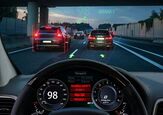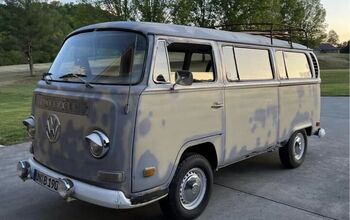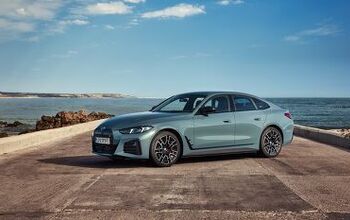The Last True Packards

1956 Packard Caribbean Convertible. Full gallery here.
Last week* was the 58th anniversary of the date that the last true Packard that was built in Detroit by the storied automaker. If you follow the conventional wisdom about Packard, one of the great American luxury car makers, two things are taken as truisms. One is that offering the so-called “junior” Packards in the 1930s, something like Buicks were to Cadillac and Mercurys were to Lincoln, what we might today call entry level luxury, fatally tainted the prestige of the brand, ultimately leading to its demise. The other is that Jim Nance, who ran Packard in its last years as an independent automaker, mismanaged the company into oblivion. Contrarian that yours truly is, I’m not sure either of those things are quite accurate.
1956 Packard Caribbean hardtop. Full gallery here.
The entry level Packards kept the company afloat until military contracts during World War II put it on good enough financial footing to have produced one of the first true postwar cars, Packard’s 1948 “bathtub” models, which sold very well that year. As for Nance, historians say that his ego prevented the merger of four independent automakers, Packard, Hudson, Nash and Studebaker that George Mason at Nash proposed, a conglomerate that could have competed with the Big 3. Also, he later agreed to a futile merger with Studebaker in 1954, a company whose financial situation by then turned out to be more dire than Packard’s. Packard wasn’t profitable but its balance sheet was still sound. Studebaker also wasn’t making money but it was in much worse financial shape.
1956 Packard Four Hundred. Full gallery here.
After the merger, in fact an acquisition of Packard by Studebaker, while the 1955 and 1956 models were genuine Packards, made by the company in Detroit, by 1957, Packards were just rebadged and restyled ( hideously so, in my opinion) Studebakers. Piscine looking contraptions that are actually collectible as “Packardbakers”. Hence the 1955 and 1956 Packards were the last true Packards and it was Nance who was responsible for them. They’re remarkable cars in a number of ways, worthy of the brand’s name, with advanced engineering features. Considering the company’s limited financial resources by then, Nance and his team did a great job. Frankly, considering their historical significance, their technical features and what I believe was a masterful styling job by Dick Teague, later to head AMC’s styling department, I’m shocked that with the exception of the Caribbean models, particularly the convertibles, 1955 and 1956 Packards sell for relatively low prices.
For the price of an unrestorable tri-five Chevy you can own real history.
I know of a 100% complete barn find 1956 Packard Patrician, the top of the line for them that year, with just about all the available options including air conditioning and Packard’s Twin Ultramatic automatic gearbox. It’s a solid car with 100% of the parts that I could buy tomorrow if I had a spare $5,000. Five grand won’t even get you a restorable 1957 Chevy these days.
1955 Packard Caribbean convertible. Full gallery here.
It’s true that following the introduction of the 1935 One Twenty models, which sold well, Packard’s managers neglected their true luxury line, allowing Cadillac to dominate the luxury market in the 1940s and early 1950s. Nance’s plan was to restore Packard’s prestige by splitting the company’s products into two lines, Packards and Clippers, reviving the latter brand name which had originally been used for a 1941 model. Though the cars were basically the same, Packards sat on longer wheelbases, had some unique features as standard equipment as well as unique options, and they had more elaborate exterior treatments with two and three tone paint jobs and lots of chrome and stainless steel trim.
1955 Packard 400, Full gallery here.
Starting in 1949, when Cadillac introduced the first mass-produced high compression overhead valve V8 engine, every automaker tried to come up with a modern V8 to stay in the game. In 1953, Nance convinced the Packard board of directors to invest $20 million in a new motor. It wasn’t an easy task. For all their engineering prowess, Packard was a conservative company and it’s straight eight engines were outstanding designs. As good as the Packard straight eights were, they couldn’t compete in terms of power or prestige with Cadillac’s OHV V8. Bill Graves, Packards head engineer, was in charge of the V8 team, made of J.R. Ferguson, Bill Schwieder, and E.A. Weiss. The design of the V8 was conventional, following the practices at Cadillac, Oldsmobile and Studebaker, but it had industry leading power, with the 352 cubic inch version in the senior Packards producing 260 hp and 275 in the dual-carb Caribbeans.
1955 Clipper. When the Clipper was introduced it was not branded a Packard, to distinguish the more expensive cars. Full gallery here.
To back up the new engine, Forest MacFarland and Herb Misch were in charge of the latest development of Packard’s own automatic transmission. Automatics were about as important for prestige cars as V8 engines were and it’s a tribute to Packard that they, among all of the independent automakers, were the only ones to develop their own automatic gearbox. Originally called the Ultramatic, the ’55 Packards were to get a new “Twin Ultramatic”. MacFarland was respected enough in his field that the SAE gives out an award named in his honor and Misch later had a distinguished career at Ford where before becoming head of engineering, he had a major role in the development of the first Mustang. Oh, and a guy named John Delorean also had a hand in the Ultramatic.
Clippers had substantially different taillights than Packards in 1955. Full gallery here.
The ’55 Packards were to have a modern powertrain, so that put them in the game. To make them stand proud of the competition, so to speak, Nance embraced a radical idea for the suspension, something branded as Torsion Level Suspension. It was originally invented by William Allison when at Hudson, but that company didn’t have the resources to fully develop it. Allison moved on to Packard and Nance gave the go-ahead to put the novel torsion bar based suspension on the 1955 senior Packards. I’ve been reading about the Torsion Level Suspension for years now, and I’m still not completely sure how it works, though both contemporary reports and today’s collectors say it indeed works, providing both a smooth ride over things like potholes and railroad tracks and better handling than the other cars of the day. In addition to all of the torsion bars, the system also was self-leveling, actuated by a solenoid activated electric motor. People would sit on the back bumper and be amazed as the car leveled itself. Though it had a seven second delay, one could call it an early example of active suspension.
For 1956, the Clipper got taillights similar to the Packards’ “cathedral” style lamps. Full gallery here.
Rather than confuse you by trying to explain something I don’t understand, I’ll let Aaron Severson, the best online automotive historian there is, tell you how Torsion Level Suspension works. You can read his full history of the last Packards over at Ate Up With Motor.
Its main springs were a pair of long torsion bars, anchored at one end to the front suspension’s lower control arms, at the other to the rear suspension’s trailing arms. A second, shorter set of bars ran parallel to the main springs, anchored at one end to the rear suspension arms (sharing the same pivot axis as the main springs) and at the other to an electric compensator motor mounted on the frame’s central X member. There was also a front anti-roll bar, while the rear suspension used two stabilizing links for lateral location.
The interconnection of the front and rear suspension meant that bumps affecting the front wheels were transmitted to the rear axle and vice versa. Since the springs were not anchored directly to the frame, the ride had an odd, floaty quality, but unlike softly sprung conventional suspensions, it sacrificed little body control. Even with Torsion-Level, no Packard could really be called nimble, but cars with Allison’s suspension handled with admirable composure, not nearly as nautically as the ride motions implied.
The electric motor had two functions. First, it kept the body on an even keel; since the springs were not anchored to the frame, the body would come to rest in any position that balanced the preloading of the springs, rather than returning naturally to a level attitude. Second, the compensator provided automatic load leveling. If a heavy load were added to the trunk, for instance, the motor would crank the torsion bars until the car was again level. There was a seven-second delay to keep the system from overreacting to bumpy pavement and a cut-off switch was provided under the dash so that the compensator would not drain the battery with the engine off.
A simplified diagram of the Packard Torsion-Level suspension. The main springs (red) are long torsion bars connecting the front A-arms to the rear trailing arms; a set of compensator springs (green) share the same pivot axis (purple), connecting the rear trailing arms to the compensator motor (yellow). The rear does not have an anti-roll bar, but there are two lateral links to locate the rear axle. (diagram, Aaron Severson, referencing 1955 Packard press illustrations)
Packard even offered a limited slip differential. The company was so proud of the engineering features they even manufactured a number of fully assembled chassis without bodies for use as dealer showroom displays. All of that technology, though, wasn’t going to overcome a somewhat stodgy image. While the ’48s were innovative, that novelty wore off quickly and the new bodies designed for 1951 weren’t terribly well received by consumers, one reason for Packard’s financial situation. For the “all new” 1955 models, with so much money devoted to the new engine, transmission and suspension, Bill Schmidt’s design team was going to have to make do with the old body shell. What lead stylist Dick Teague came up with was so good that it’s hard to tell that they recycled. Not only that, but the design was contemporary and modern looking, not at all out of place with 1955-1957 cars from GM, Ford and Chrysler.
1953 Packard Balboa. Full gallery here
They had wraparound windshields, eggcrate grilles, hooded headlamps, “cathedral taillights” (Clippers had smaller “slipper” lights in back), and a continuous fender line running from front to back, elevating as it reaches the rather tall tail lamps, achieving the look of tail fins. By 1955 cars were getting lower so to make the tall 1951 body appear less so, ribbed chrome side moldings along the flanks visually lowered them. Also, by 1955 two door hardtop sedans were gaining popularity and for the first time the Patrician got a true hardtop companion, the Four Hundred.
“Cathedral” taillights on a 1955 Packard Caribbean. Full gallery here.
Sales nearly doubled from 1954, so the board approved a modest redesign for 1956. Most noticeable are longer “eyelids” over the headlights. There were also some mechanical improvements, and the board also approved the introduction of a Packard Executive model, above the Clippers but below the Patrician, Four Hundred and Caribbean. Engine displacements increased, as did power. The Patrician got a 374 CI engine that put out 290 hp. Again Packard led the industry with 310 horsepower in the Caribbean. The Twin Ultramatic got a optional push button control, a popular feature in the 1950s, now returning at some brands.
1956 Packard Executive. It combined a Packard front end with a Clipper rear end. Full gallery here.
On paper the new Packards should have been great. Unfortunately they were compromised by quality control, mostly a result of moving production out of the old plant on East Grand Blvd, the one that’s featured in most ruin porn you see from Detroit, to a factory on Conner Ave where the company had started building their own bodies after their body supplier, Briggs, was bought out by Chrysler. Packard’s shrinking dealer network contributed to the quality issue. The Twin Ultramatic isn’t a great transmission, by TurboHydramatic standards, but it works well enough if it is maintained properly. The same is true about all the switches and solenoids used in the Torsion Level Suspension. Cars back then needed a lot of regular maintenance, with some tasks performed every 1,000 or 2,000 miles. Independent repair shops simply didn’t see enough Packards to learn how to maintain and repair them properly. The brand’s reputation suffered. By 1956, the word got out about quality and sales dropped to only 7,568 Packards and about 21,000 Clippers. It should be noted that ’55-’56 Packard enthusiasts point out that when properly maintained, their cars’ transmissions and suspensions work just fine.
1956 Packard dealer showroom display chassis. Full gallery here.
In the summer of 1956 the Studebaker board stepped in and ended Packard production in Detroit. The death of Packard has been covered numerous times, from numerous angles, since 1958, but I didn’t want to dwell on the death of a great car company in this piece. Rather I wanted to show that while Packard went out of existence as a Detroit automaker, they went out on a high note. James Nance may have made some mistakes, but it was no mistake to make the last Packards automobiles worthy of the marque.
A nameplate after our Editor in Chief pro tem’s own heart. “The Patrician”.
The cars pictured here were photographed at various Detroit area shows, including the Concours of America, the Orphan Car Show, Eyes On Design and shows at the Packard Proving Grounds.
*The History Channel says that the last Packard built in Detroit was assembled on June 25, 1956. Old Cars Weekly says that it was a few weeks later, August 15th.
Ronnie Schreiber edits Cars In Depth, a realistic perspective on cars & car culture and the original 3D car site. If you found this post worthwhile, you can get a parallax view at Cars In Depth. If the 3D thing freaks you out, don’t worry, all the photo and video players in use at the site have mono options. Thanks for reading – RJS

Ronnie Schreiber edits Cars In Depth, the original 3D car site.
More by Ronnie Schreiber
Latest Car Reviews
Read moreLatest Product Reviews
Read moreRecent Comments
- Jeanbaptiste I know this will never be seen, but the real answer is NO Government mandated tech. The reason why is that when the government mandates something, we miss out on signals that the free market will give to weather or not people actually want this or that this tech would actually help. It's like mandating AM radio for cars when people could just buy a $10 am radio if they really like am so much.
- 28-Cars-Later $12K? I needed a good laugh.
- EBFlex Wait...the feds are claiming that inflation was not FJBs fault 6 months prior to an election where he is massively losing in the polls in every single category?Eyebrow raised.
- MaintenanceCosts Most of the article after the blockquote is Posky laboring mightily to somehow blame this clearly anticompetitive and oligopolistic conduct on the big bad government.I look forward to some of the usual commenters explaining to us that, actually, the oil industry is a cuddly teddy bear and the real villain is people trying to sell us cars that don't use oil.
- Bd2 A modest price bump for one of the better if not the best vehicle in it's class. And it's a very good deal still considering the Front wheel drive competition over at Lexus to name one. These Genesis vehicles are more like BMWs of the 90s but with better styling.















































Comments
Join the conversation
I've got a '56 Caribbean convertible for sale. :)
Excellent summary, and one of the first entirely fair assessment to the cars themselves I have read that is completely free of big 3 bias. One small correction: all Detroit operations of the Studebaker-Packard Corporation (=Packard) were ordered shut by the officials at The Curtis-Wright Corporation, who were the new owners of S-P after the company went broke in mid-1956. They were active on the Studebaker board, but they were running everything. Curtis-Wright was a huge defense contractor making impressive profits in missile and aircraft contracting to the military, and they needed a tax write-off, at least for the time being. To be sure, and as other respondents have clarified, Packard bought Studebaker. Mason's death was the end of the 4-independent brand AMC idea, Romney did not share Mason's inclusion of Studebaker and Packard, personalities aside.